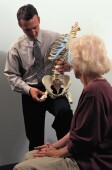
THURSDAY, March 11 (HealthDay News) — Long-term use of oral drugs prescribed to keep osteoporosis at bay may be associated with unusual fractures of the thigh bone, two new studies suggest.
The research is not the first to link the drugs, known as bisphosphonates, with unusual fractures. Other research has found pros and cons, with the drugs reducing breast cancer risk but increasing the risk of painful jaw problems.
“Bisphosphonates are a good first start,” said study co-author, Dr. Melvin Rosenwasser, a professor of orthopedic surgery at Columbia University College of Physicians and Surgeons in New York City. “Used beyond a certain point, yet to be determined, they may actually be bad.”
The research is scheduled for presentation Thursday at the American Academy of Orthopaedic Surgeons’ annual meeting in New Orleans, but at least one expert is saying both new studies are flawed.
In his study, Rosenwasser and his colleagues focused on 112 women, all past menopause, who had osteoporosis, which weakens bones, making them more likely to break. Of them, 62 took osteoporosis drugs — in this case, bisphosphonates — for four years or more, and 50 took calcium and vitamin D supplements only.
The researchers took bone scans to evaluate the thigh bone structure.
“That allowed us to show changes in the buckling ratio,” said Rosenwasser. “That’s a fancy way of saying the propensity for the bone to break.”
They found that long-term use of the drugs — at least four years — was associated with an increase in the buckling ratio, reflecting a higher risk for fracture.
In another study, Dr. Joseph M. Lane, chief of the metabolic bone disease service at the Hospital for Special Surgery and a professor of orthopedic surgery at Weill Cornell Medical College in New York City, and his colleagues compared bone quality in biopsies from patients who had been on bisphosphonates for several years with those not on the drugs.
They looked at bone biopsies taken from the thigh bones of 21 women, all past menopause, who had suffered fractures at the site. Nine had not taken the drugs, while 12 had, for an average of 8.5 years.
“We took bone from close to the fracture site,” Lane said. The women on the bisphosphonates, they found, had “old” bone. Normally, Lane said, bone is about 20 percent new, 60 percent middle-age and 20 percent old. “This was 90 percent old bone, suggesting the body is not turning over the bone,” Lane said.
When too much of the bone is old bone, Lane said, it lacks the ability to repair microdamage. “What I think is happening is, women keep doing microdamage to the bone,” he said. As a result, the unusual fractures of the thigh bone can occur with simple activity, such as climbing stairs.
At least one other expert isn’t so sure. Criticizing both studies, Dr. Nelson Watts, director of the University of Cincinnati Bone Health and Osteoporosis Center, said the research has “major flaws” and “major errors in interpretation.”
“They’re looking at too small a sample size,” he said .
Watts, who has been involved in clinical trials with bisphosphonates, said the drug studies typically have thousands of subjects and “we don’t see these fractures.”
The link could be a chance association, said Watts, who has been a consultant for makers of osteoporosis medications. “If there is a causal association,” he said, “it appears to be limited to a small subset.”
Neither Rosenwasser nor Lane is suggesting that bisphosphonates be abandoned. Both agree they can help soon after a diagnosis of osteoporosis. But after a certain point, they said women may be better off going off the drug or switching to another type of osteoporosis drug.
More information
To learn more about fractures, visit the American Academy of Orthopaedic Surgeons.

